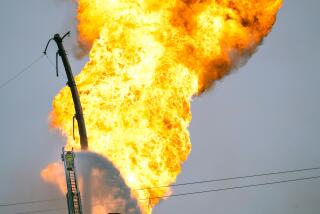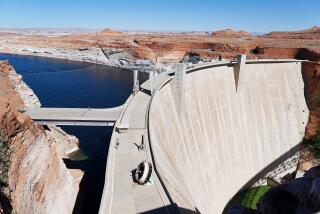North Dakota pipeline spill raises questions amid state’s oil boom
WASHINGTON — About sundown one Sunday in September, North Dakota farmer Steven Jensen noticed that his combine was running over wet, squishy earth in a wheat field he was harvesting. When he took a closer look, he saw that oil had coated the wheels and that it was bubbling up about 6 inches high in spots.
That was Sept. 29; Jensen contacted authorities immediately. At least 20,600 barrels of oil leaked onto the Jensens’ land from a pipeline owned by Tesoro Logistics, one of the largest land-based spills in recent history. Neither the pipeline company nor the state informed the public of the spill for 11 days.
Since then, why there was a delay in disclosure has proved to be one of several fundamental questions that Tesoro and state authorities have yet to answer. No one knows how long the pipeline was leaking before Jensen discovered it, nor why sensors on the pipe failed to detect the leak. Neither the state nor the company could say what the pipeline’s capacity was. Experts on pipeline spills question the accuracy of Tesoro’s leak estimate, disputing its methodology.
Jensen estimates that more than 20 acres have been affected by the spill and cleanup effort. He says Tesoro appears to be working hard to contain the spill, but he worries that it could seep into groundwater.
The questions have stirred concerns about North Dakota’s handling of a major spill, especially because thousands of miles of pipe are being installed as part of the state’s oil boom.
“If there is a spill of any sort, the public should be told immediately, so that they have confidence that their officials are responding appropriately,” said Mac Schneider, a Democrat from Grand Forks and the minority leader in the state Senate. Schneider said he knew only what he “read in the papers.”
Tesoro said it sent a news release about the spill on Oct. 10. Kris Roberts, who is leading the North Dakota Health Department’s work with Tesoro on the cleanup, said the state saw no need to publicize the spill immediately because the site was remote.
“It’s on top of a low hill, in the middle of a wheat field, in an area with no residents at all,” Roberts said. “The public has a right to know. But do I have a responsibility to run out and tell the public every time there’s a spill that isn’t going to threaten them or the environment, and that the company is aggressively cleaning up?”
The North Dakota spill comes amid a national debate over granting a federal permit to the giant Keystone XL pipeline, which would transport tar sands oil from Canada to Texas. In March, an Exxon pipeline burst in Mayflower, Ark., spewing about 5,000 barrels of oil into a subdivision and a lake. In Michigan, cleanup continues on a spill of more than 20,000 barrels of oil into the Kalamazoo River that occurred in mid-2010.
Jensen smelled the oil in the wheat field before he saw it, raising questions about how long the pipe had been leaking. On Sept. 25, as Jensen was harvesting two miles from in his home in Tioga, he smelled what he thought was oil drilling at a nearby property. Bad weather kept him away from the field until the 29th, when he drove across the oil-soaked section.
The 35-mile-long Tesoro pipeline, which carries oil from Tioga to a rail depot near Columbus, N.D., was laid 20 years ago, meaning it is relatively new. But a pipeline’s age has little bearing on reliability, with leaks more often linked to soil conditions and maintenance, said Carl Weimer, executive director of the Pipeline Safety Trust, a watchdog group in Bellingham, Wash.
Tesoro and regulators are trying to determine exactly when a quarter-inch hole opened in the pipe, which is 6 inches in diameter and buried about 6 feet deep. The company’s leak detection sensors on the line failed, which Tesoro termed “unacceptable.”
Tesoro tested the pipeline and others in the area in early September but did not get the results until Oct. 14. The tests showed weaknesses at several places, including the spill site, the company said.
After learning about the leak, Tesoro said, it shut down the line within 10 minutes, and a representative was there within hours.
The company initially reported that 750 barrels had spilled, but a week later revised it to 20,600. Tesoro based its estimate on soil samples over the 7-acre site, where the oil saturated soil about 3 feet down.
But Steve Wereley, professor of mechanical engineering at Purdue University and an expert on spill flows, said such methodology gave Tesoro “just the roughest of ideas” about the spill’s size.
“They should know how much oil they put in at the oil field, and how much oil they get at the rail depot,” said Wereley, who helped establish an accurate flow rate for the 2010 Deepwater Horizon oil spill in the Gulf of Mexico. “If we’re talking about tens of thousands of barrels, shouldn’t you notice 20,000 barrels missing at the end?”
Tesoro said it was investigating whether there was a discrepancy between oil that went into the pipe and what was received at the rail depot.
The company has cleaned up about 3,000 barrels of oil. The remediation is expected to continue until late 2014 and to cost about $4 million, the state and Tesoro said.
But Jensen is worried.
“They’ve been really nice and they’ve contained the spill as well as they can,” he said. “But I still don’t know if it will get into the water.”
More to Read
Sign up for Essential California
The most important California stories and recommendations in your inbox every morning.
You may occasionally receive promotional content from the Los Angeles Times.











